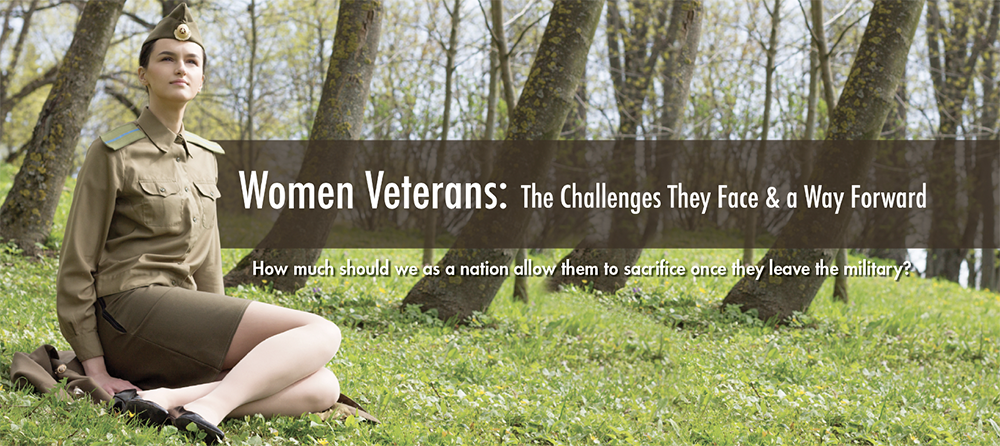Although not officially recognized as members of the armed forces until 1901, the involvement of women in the military dates back to the Revolutionary War.
Each year, the population of women veterans grows steadily due, in part, to the increasing number and proportion of women entering and leaving military service. Most women veterans possess those traits that are valued in military service and beyond: steady nerves, sound judgment, courage, tenacity, patriotism, and sacrifice. The question is, how much should we as a nation allow them to sacrifice once they leave the military? Do we adhere to what President Lincoln said so many years ago? With the words, “To care for him who shall have borne the battle and for his widow, and his orphan,” President Lincoln affirmed the government’s obligation to care for those who serve. Clearly he wasn’t expecting to add women to his speech but here we are, serving right beside our male brethren as a force multiplier adding value in ways never expected.
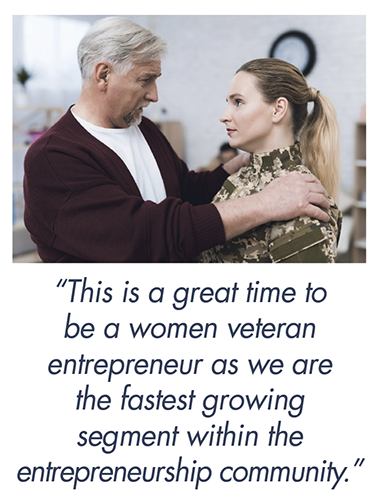 Women have proudly served their country throughout all periods of United States history, whether disguised as male soldiers during the American Revolution and Civil War, as nurses in World War I. They have taken roles in aviation, medicine, communications, intelligence, science, and technology fields during WWII, and in combat arms during OEF/OIF. It is the extent of their involvement, degree of militarization, and integration into the services that have changed dramatically over time.
Women have proudly served their country throughout all periods of United States history, whether disguised as male soldiers during the American Revolution and Civil War, as nurses in World War I. They have taken roles in aviation, medicine, communications, intelligence, science, and technology fields during WWII, and in combat arms during OEF/OIF. It is the extent of their involvement, degree of militarization, and integration into the services that have changed dramatically over time.
Unique Challenges: Women veterans face unique challenges that their male veteran counterparts and female business owners do not. As the fastest growing cohort within the veteran community at 9.4 percent (2M), expected to grow to 16.3 percent by 2043, it is imperative we capture data on this demographic in order to address specific needs. Historically, only 1.4 percent of all female Americans have served in the armed forces. Their unemployment and suicide rates are at an epidemic high; are less likely to win contracts and ask for loans; have higher rates of homelessness; and lack VA mental and physical health care addressing women’s needs. They may become entrepreneurs by necessity as they face unusually high unemployment rates of 11.1 percent compared to 7.1 percent for other women. Younger women veterans face a rate of 35.4 percent.
They also face the cultural challenge of going from a soldier to what society expects of appropriate female behavior. They are more likely to have family to take care of and have a harder time translating their military experience into civilian speak. Even if they were combat arms, males are often seen as warriors and women veterans regularly do no self-identify as a veteran.
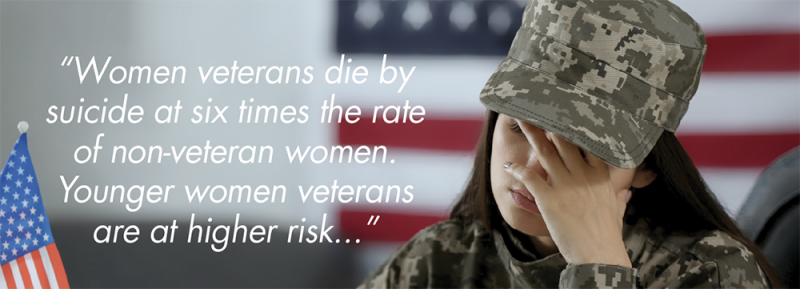
Then, there are factors like the lack of access to capital women face, as a whole. They are 21 percent less likely than males to win government contracts. A recent report revealed that women are less likely to ask for business loans out of fear of being denied, even though their financial profiles are often better than their male counterparts.
Women veterans are three times as likely to experience homelessness and poverty over non-veteran women. They suffer higher rates of PTSD and depression over their male veteran counterparts, but less substance abuse. According to the VA, women veterans die by suicide at six times the rate of non-veteran women. Younger women veterans are at higher risk at 12 times the rate of non-veteran women. Compare this to male veterans who have twice the rate of suicide over non-veteran males. It is an epidemic. While only constituting 15 percent of the military, women account for 95 percent of reported sex crime victims and are considered seriously underreported due to retribution.
From 2005 to 2015, the number of women veterans using VA health care increased 46.4 percent, from 237,952 to 455,875. The changing demographics of the women entering, and ultimately leaving, the Armed Forces have an impact on the kinds of services they will require in the future. As more and more women move into the ranks of veterans, it becomes important to investigate their post-military outcomes. Who are women veterans, and how are they different from their non-veteran counterparts? How do women veterans use the benefits and services?
Finally, we should be connecting women veterans to help each other through the transition. When attending veteran events, it is apparent there are few women participating or in positions of leadership. Many voice their frustration of being the minority and feeling out of place. We should be working to unite this demographic amongst their peers. There is inherent trust amongst women veterans, and they are willing to learn from one another because of a sense of community and shared experiences. By providing these women purpose, it is powerful.
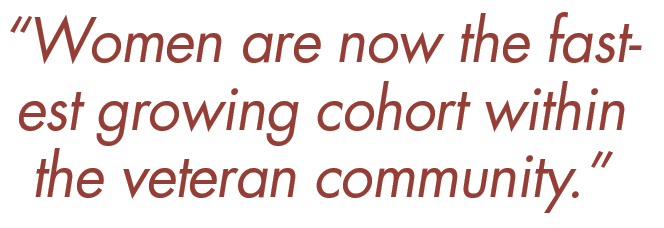
Timing: It is somewhat unclear what is causing these rates due to serious lack of data. What we do know is if we provide them the tools to be successful in business, it gives them purpose and a livelihood they can be proud of. By empowering them to make up for lost time while they were serving their country, they add to the system instead of drawing from it, which ultimately helps the veteran, the community and nation.
Veteran women entrepreneurs possess traits that make them ideal business owners. Due to military training and knowledge, veterans are dependable, conditioned to make hard decisions, have integrity, take initiative and can adapt easily to challenging and evolving situations—all characteristics of a successful business owner. These women may see entrepreneurship as a means to prosper on their own terms by being their own boss.
This is a great time to be a woman veteran entrepreneur as we are the fastest growing segment within the entrepreneurship community increasing by an astonishing 296 percent since 2007. Some of the reasons include a slight increase in women veterans; they are building businesses out of necessity; 40 percent of veterans are going into business for themselves as compared to the 10 percent Vietnam era entrepreneurs; more veterans have disability ratings than in wars past due to technology and better equipment; recent positive legislative changes; demand for third party corporate certification; and more available resources in terms of capital, education and counseling.
It is important to note that despite the hurdles, veteran business owners have proven to be twice as successful in terms of revenue and business longevity, are twice as likely to hire other veterans, and contribute over $1.2T in sales receipts, $210B in annual payroll and employ over 5.79 employees. In 2012, veteran women-owned businesses were responsible for nearly 20 billion in receipts-a
n increase of 26.3 percent since 2007.
Veteran women continue to serve the United States by reinvesting and devoting themselves to the future, not through military service but through entrepreneurship. They are no stranger to hurdles and overcoming barriers as many dealt with this routinely while serving in a male-dominated profession. They are strong, smart and driven, but we must understand specific challenges they face so we can help them be successful. Through entrepreneurship, many of the issues the community faces subside. Instead of masking the problem through medication prescribed at record rates, healthcare systems trying to keep up with a new demographic, and job placement programs in which the majority of veterans quit by year two, let’s put our efforts towards something that is working. It is not only a moral imperative that we take care of them, but an economic one as well.
Backup: Currently not one document lays out the issues and statistics-this is a compilation of data from many credible sources: VA, US Census Bureau, DOL, SBA, DOD, Public Law, GAO, American Community Survey, National Center for Veterans Analysis and Statistics, VetPop2104, Defense Manpower Center, National Women’s Business Council, Women Impacting Public Policy, Disabled American Veterans, and Forbes.
• The overall veteran population is projected to decline over the next 25 years; however, the number of female veterans
will increase both in absolute and relative terms.
• Women are now the fastest growing cohort within the veteran community.
• In 2015, women comprised 9.4 percent of the total veteran population in the United States at 2M. By 2043, women are projected to make up 16.3 percent of all living veterans.
• The total population of women veterans is expected to increase at an average rate of about 18,000 women per year for the next 10 years.
• Women represent about 15 percent of active duty military, 18.8 percent of the Reserve and Guard, and 20 percent of new recruits, according to the U.S. Department of Defense. Nearly 280,000 women have served Post 9/11 in Afghanistan and Iraq.
• Roughly 25 percent of women veterans served only in peacetime defined from 1975-1990
• Most women veterans alive today served only during Post-9/11 period of military service, or September 2001 to present.
• Women veterans represented 11 percent of the forces that have deployed in support of Iraq and Afghanistan, representing the largest cohort of women in history who were extensively i
nvolved and active in combat operations.
• In 2015, 23.4 percent of all women veterans were currently divorced compared with 12.6 percent of non-veteran women.
• In 2015, 19 percent of women veterans were African American, compared with 12 percent of non-veteran women. African American women are also overrepresented compared to African American men in the military.
• Twenty-percent of all living women veterans served only during peace times. Fifty-six percent of all women veterans have served during the Gulf War Era (August 1990 to the present).
• A higher percentage of employed women veterans 17 to 64 years old worked in the government sector (34 percent) than non-veteran women (16 percent).
• About 10 percent of all women veterans and 15 percent of all non-Veteran women had incomes below the poverty threshold.
• Roughly 44 percent of women veterans had some college as their highest level of education compared to 32 percent of non-veterans. Overall, a higher percentage of all women veterans (34.5%) than non-veterans (28.1%) had completed a Bachelor’s or advanced degree.
Women Veterans Mean Business
• As of 2012, there are 383,302 veteran women-owned businesses in the U.S., making them the fastest-growing segment within the entrepreneurship community. This reflects an increase from 2007 of nearly 300 percent, or an additional 286,188 businesses.
• During that same time period, by comparison, the number of businesses owned by male veterans actually decreased by 7 percent, and the total number of businesses, nationwide, grew by about 2 percent.
• The number of women veteran business owners has expanded rapidly. In 2008, only 2.5 percent of veteran business owners were women; as of 2012, that number was up to 4.4 percent.
• In 2007, 4 percent of U.S. businesses were veteran women-owned. By 2012, it increased to 15.2 percent
• In 2012, veteran women-owned businesses were responsible for nearly 20 billion in receipts in 2012, an increase of 26.3 percent since 2007.
• States with the highest number of veteran women-owned firms include California, Texas, Florida, New York, and Georgia.
• Top industries include Other Services, Health Care and Social Assistance, Administrative and Support and Waste Management Remediation Services. Professional, Scientific and Technical Services and Retail Trade.
• 30 percent: The portion of all American businesses owned by veterans; interestingly, while veterans make up only 8 percent of the U.S. population, they are twice as likely to own a business as the general population.
• Studies show that veteran business leaders, male or female, tend to hire veterans at twice the rate of non-veteran firms and are twice as likely to be successful in terms of longevity and revenue.
The Business Landscape for Women
• A report by Babson College on the Goldman Sachs 10,000 Women Initiative revealed that women are less likely to ask for business loans out of fear of being denied, even though their financial profiles are often better than their male counterparts.
• Women business owners in general are 21 percent less likely to win federal contracts over men—more data is needed to determine what the disparity is for women veterans.
• Thirty-nine percent of women looking to expand their businesses get a conventional loan, compared with 52 percent of male-owned companies.
• Women account for only 16 percent of conventional small business loans and 17 percent of SBA loans, even though they represent 30 percent of all small companies. Of conventional small business loans, women only account for 4.4 percent of total dollar value of loans from all sources. In other words, just $1 of every $23 in conventional sma
ll business loans goes to a woman-owned business.
• Women receive just 7 percent of venture funds, and the percentage of female venture capitalists has actually declined from previous years. That decline means less women are in the position to support women entrepreneurs by investing in their growth.
• Women in contracting terms are considered minorities. Additionally, being a veteran is a subset within the women business owned group in which very little data exists to show disparities. It is known that minority firms indicate large disparities in access to financial capital, are found to pay higher interest rates on loans, are more likely to be denied credit, and are less likely to apply for loans because they fear their applications will be denied. Furthermore, minority-owned firms are found to have less than half the average amount of recent equity investments and loans than non-minority firms. Even though minority status helps in some areas of contracting, there seems to be more barriers to overcome than the benefit of being a set-aside group.
Unemployment
• The current unemployment rate for women who have served since 9/11 is 11.4 percent compared to 7.1 percent for other women, while that same rate for male veterans is 4.5 percent.
• Among young female veterans, the numbers are worse for ages 20-24 having an unemployment rate of 35.4 percent.
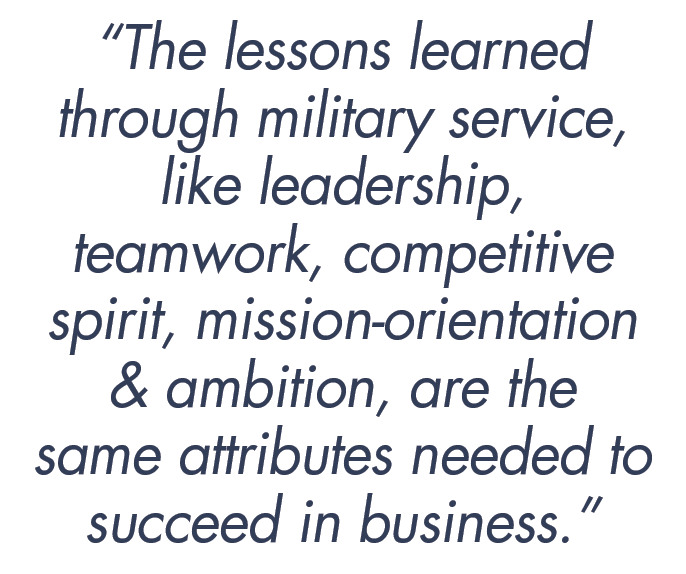
• Women vets have a lower workforce participation rate – according to the BLS, 61.9 percent of female veterans are in the labor force, while that same number is 81.6 percent for men. This doesn’t even take into account those women who are so discouraged they drop out of the labor force entirely.
• Female veterans are more likely to have children and family to take care of than male veterans, making it harder for them to find and hold down a job.
• Studies have shown that if a male and female veteran interview for the same job, the male veteran is seen as the ‘warrior’ despite the fact that the woman may have encountered much more danger over the course of her career. Often, the male gets the position, even if both are equally qualified.
• Homeless women veterans face substantial barriers to employment. According to the VA, 77 percent of homeless female veterans were unemployed. One of the key factors for this larger percentage could be the lack of accessible and affordable child care.
Homelessness
• Veteran women are more than three times as likely as non-veteran women to live in poverty and experience homelessness.
• The number of women veterans accessing VA specialized homeless programs has tripled in the last five years.
• It is estimated that between now and 2020 there will be an increase of 4.4 percent participation in VA homelessness programs. From now to 2025, the number will rise to 9 percent.
• HUD determined that 9.1 percent of the entire veteran homeless population are women.
• It is estimated that 2 percent of all women veterans and 13-15 percent of them living in poverty experience homelessness for over a year.
• Nearly 80 percent of homeless veterans suffer from mental health disorders, drug and/or alcohol abuse, or co-occurring disorders.
• In 2014, 40 percent of homeless female veterans were middle-aged using VA’s homelessness programs, 31 percent were considered older, 8.5 percent are OEF/OIF and 4.3 percent are considered younger women veterans.
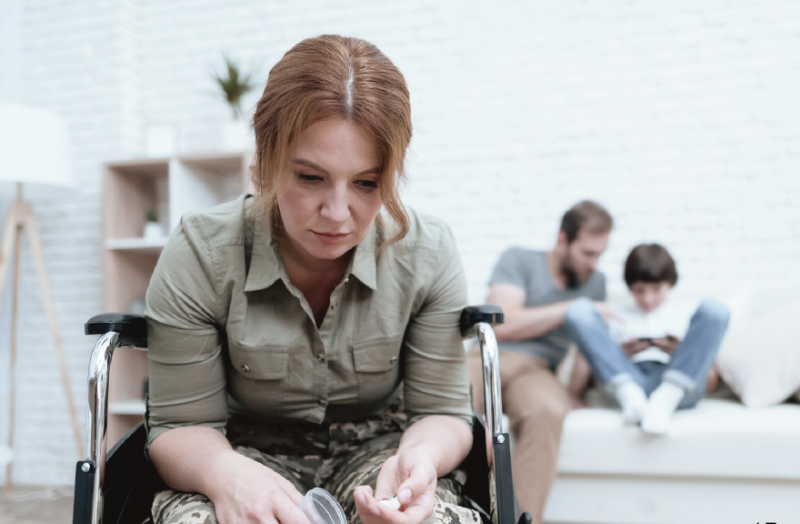 Mental and Physical Health
Mental and Physical Health
• While only constituting 15 percent of the military, women account for 95 percent of reported sex crime victims. According to a recent Pentagon report, the rate of violent sexual crimes within the military has increased by 64 percent since 2006.
• The Department of Defense is aware that this is a “very under-reported crime,” for fear of retribution with actual incidents of military sexual assault (MSA) being 6 times higher than reported.
• Because those who experience personal violence, including rape, are 6.5 times more likely to experience homelessness, women veterans who have experienced Military Sexual Trauma are at a greater risk for experiencing homelessness, especially when compounded by PTSD.
• Data from 2012 show women are less likely to be diagnosed with a substance abuse problem over male veterans, but are more likely to have serious mental health illness, particularly PTSD and depression.
• Because veterans are overwhelmingly male, many of the VA programs designed to help veterans have do not serve the specific needs of women veterans. Despite this rapid and significant rise in the number of women veterans, VA programs are slow to change to address this changing demographic.
o A third of VA clinics don’t even have gynecologists on staff.
o Thirty-one percent of VA clinics lack the resources to provide treatment for sexual assault despite the fact that approximately 1 in 4 women report having experienced military sexual trauma.
• The VA lists women veterans as a top priority through the increasing quality and accessibility of its services, through outreach and education campaigns that specifically target women veterans, and through the creation of additional surveys and research agendas that focus on the needs of women veterans.
• According to the VA, women veterans also die by suicide at 6 times the rate of non-Veteran women. Younger women veterans are at higher risk at 12 rimes the rate of non-veteran women. By contrast, male veterans have twice the suicide rate as their civilian male counterparts.
• From 2005 to 2015, the number of women veterans using VA health care increased 46.4 percent, from 237,952 to 455,875. To put this in perspective, about 13.1 percent of all women veterans in 2005 used VA health care compared with 22.4 percent of all women veterans in 2015.
• In 2015, 405,418 women veterans received compensation from VA for a service-connected disability, representing about 20.1 percent of the total population of women veterans. Fifty-four percent of women veterans receiving compensation had a combined disability rating of 50 percent or higher.
• The top five conditions for women veterans in 2015 (post-traumatic stress disorder, major depressive disorder, migraine, lumbosacral or cervical strain and uterus and ovaries removal) accounted for roughly 33 percent of all service-connected disabilities for women veterans.
• Of the women veterans receiving compensation for a service-connected disability, roughly 72 percent were between 25 and 54 years old (Figure 22). Women ages 45 to 54 made up 26 percent of the total population of women veterans receiving service-connected disability compensation in 2015.
• In 2015, 149,375 women veterans used education benefits. This represented about 7.4 percent of the total population of women veterans. Roughly, 61.2 percent of women veterans who used education benefits did so from age 25 to 34 years old.
• Many studies show women increasingly feel ignored, dismissed, disenfranchised as everything is centered around male vets-going back to pre 1970s terminology of the ‘invisible veteran’.
• Women veterans are unlikely to self-identify as women veterans, especially for those that have not served on active duty abroad.
• Historically, only 1.4 percent of all female Americans have served in the armed services, compared to 13.4 percent of all male Americans. This is one reason women feel alone, especially when trying to relate to the vast amount of women who have never served.
• Current numbers show all living Americans who have served in the military at some point in their lives is at 7.3 percent, and women make up less than 1 percent of living veterans.
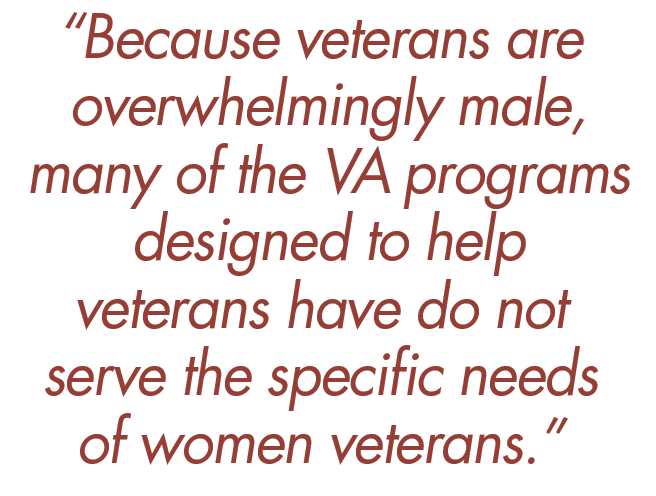
Military Veterans in Business as a Whole
Despite common misconceptions and stereotypes, successful veterans are not wedded to bureaucracy. In fact, they thrive in small groups, having led small teams or platoons throughout their military career. They are flexible, having been plunged into a highly unique environment with pressure cooker situations requiring literal do or die-based skill training. They learned how to be leaders early in their career, know how to execute plans and have the drive and desire to continue to be leaders after military service.
The lessons learned through military service, like leadership, teamwork, competitive spirit, mission-orientation and ambition, are the same attributes needed to succeed in business. More veterans are born with winning entrepreneurial personality traits, which combine well with military training and experience. According to a 2009 study on veterans in the entrepreneurial world, veterans possess greater entrepreneurial personality characteristics than those who are not veterans. Bow Rodgers, an angel investor, veteran and president of Vet-Tech, and Doug Doan, veteran and founder of Hivers and Strivers, have identified the following skills and personality traits that make veterans good entrepreneurs:
• Early leadership training: The armed services teach leadership to all recruits, and provide experiences needed to practice what they have learned.
• Leadership growth: Many are eager to continue being leaders even after they leave the service. Twenty percent of every dollar spent on an Army officer, for example, is spent on professional development.
• Working with teams: Whether on the battlefield or in strategic planning, veterans are surrounded by teammates, which serves them well when running a business.
• Focus and execution: “American soldiers get more done by 9 a.m. than most people do in a day,” touts a NaVOBA flyer that urges people to “Buy Veteran.” With this work ethic, it is no wonder they make great entrepreneurs. “These are fine young men and women with fine ideas who have the ability to execute,” Rodgers says. “If you don’t have the team to execute, what good is the good idea?”
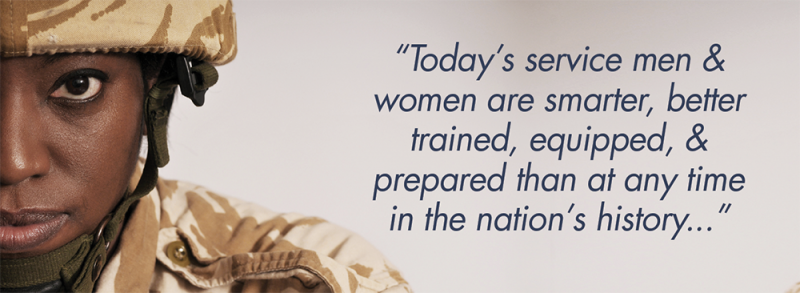
• Progress after a failure: “The military’s culture has adapted to support the development of leaders well-suited for entrepreneurship by teaching how to plan for failure, how to seek knowledge from direct reports, and how to learn iteratively as a group. The military entrusts significant authority to junior leaders who are expected, and encouraged, to fail during the early stages of their careers,” writes veteran entrepreneur Blake Hall. “A 22-year-old responsible for leading 46 men and tens of millions of dollars of equipment is going to screw up. He/she is also going to develop much faster as a leader relative to peers.”
• Knowledge seekers: Veterans are good at seeking knowledge from subordinates and learning iteratively. They review what did and did not work after every exercise, something that serves startups well.
• True doers: Many vets who joined the military after 9/11 were driven, unafraid, and determined to directly confront the biggest challenges of the era. Having elected to shoulder the responsibilities themselves rather than watch or comment from a safe distance, they are the “true doers” of this generation.
• Best practices: Today’s service men and women are smarter, better trained, equipped, and prepared than at any time in the nation’s history, especially those coming out of the military academies.

 Login
Login

